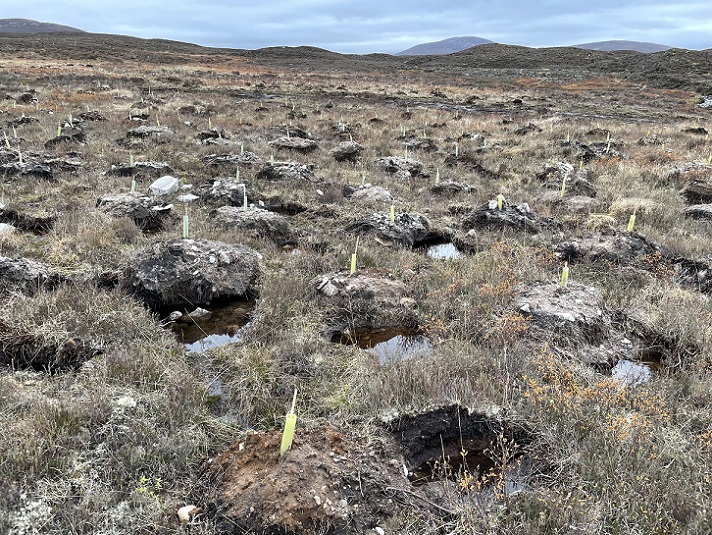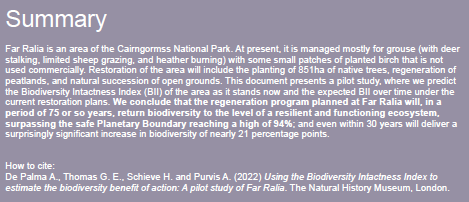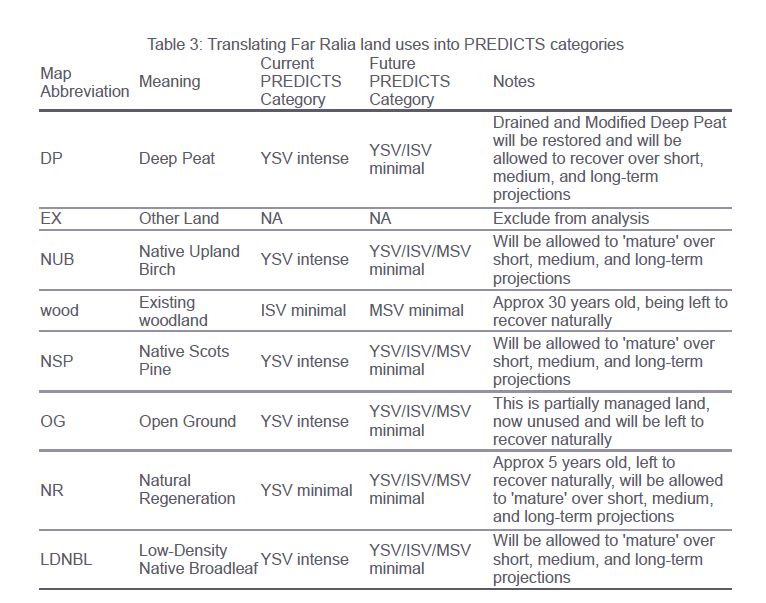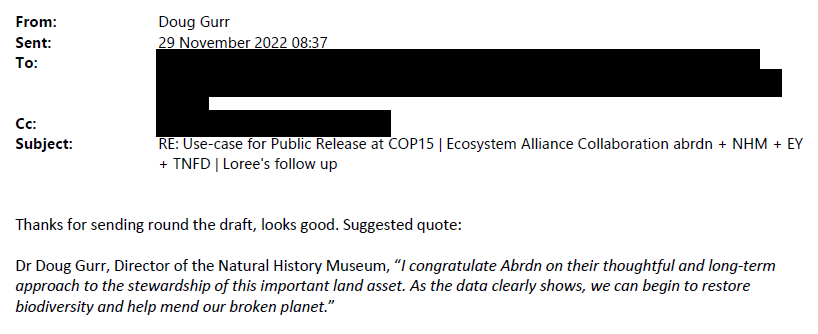
Besides operating as a museum, the Natural History Museum (NHM) in London promotes itself (see here) as having “world-class expertise” and being able to help tackle the biggest challenges facing the world today.” When it came to native woodland that certainly used to be the case, as anyone will know who has read Richard Fortey’s wonderful book, “The Wood for the Trees: one man’s long view of nature”. After buying 4 acres of ancient woodland in the renowned palaeontologist enlisted various former colleagues at the NHM to help study its wildlife. However, the NHM’s Biodiversity Intactness Index (BII), which is being used in conjunction with financial interests and has been used to help justify ABRDN’s planting at Far Ralia (see here) and (here) is another matter.
This is the first of two posts which will explore how the BII is being used and for what purpose.
The Biodiversity Intactness Index and Far Ralia
In its Far Ralia Case study (see here) Akre Trees, managed by Renwick Drysdale, a son of a trustee of the former owner who sold the land to ABRDN (see here) claimed his company, AKRE, had “partnered with the Natural History Museum (NHM) to measure Far Ralia’s biodiversity using the Biodiversity Intactness Index (BII) that helps establish a baseline and also understand, monitor, and communicate biodiversity changes and track progress”. As a consequence of this work, AKRE claimed that its woodland creation scheme with ABRDN at Far Ralia would restore Biodiversity Intactness from its current level of 52% to over 95% by 2097.

In 2020 the NHM published a report “Using the Biodiversity Intactness Index to estimate the biodiversity benefit of action: A pilot study of Far Ralia” (see here). AKRE’s figures and graphic are basically the same – ignore the trees in the top graphic – as those in this report:

The message is that everything that AKRE and ABRDN is doing is Far Ralia is astonishingly good for biodiversity. But is it?
Might not, for example, the mounding, unlawful track upgrade, driving vehicles all over the moor and other human interventions on the site create a setback for biodiversity intactness in the short-term, much like the Carbon Calculator for Far Ralia (see link above) shows carbon will be released from the site for the first 15 years? If so, should there not be a “dip” on the graph before it commences its relentless ascent?
The report states the “BII is an indicator of the ‘health’ of nature, with a value between 0 and 100%. A BII value of 100% is what we would expect to see if an area is unimpacted by humans – it still supports only native species at their natural abundances“. This is also referred to as a natural environment in pristine condition. While the report provides no example of the other end of the range, 0%, the BII is defined as “the percentage of the original ecological community that remains across
an area”.
How sound is the NHM report?
While described as “a pilot”, the NHM report contains some basic errors and fails to answer some fundamental questions about the methodology used to justify its claims.

The claim that Far Ralia “at present (i.e. December 2022) is managed for grouse, deer stalking, sheep grazing and heather burning” is contradicted by AKRE’s website which claimed that the land had not been “used for rural sporting pursuits or farming for decades” while their application to Scottish Forestry for a Woodland Grant (they were awarded c£2.5m) stated that sporting activities ceased in 2020:

The mistake is important as it affects the theoretical baseline for the graph with some areas having started to recover from overgrazing and muirburn, as evidenced by the natural regeneration on site which was described and included in Akre’s Woodland Grant Application and partly attributed to an unnamed neighbouring estate [Wild Land Ltd] culling deer (see here for photos)..
The NHM’s graph contains two lines, a solid one showing “change in biodiversity intactness index (%) over time after planting scheme” and a dashed one comparing this to “no intervention”, i.e. if farming, grouse shooting etc had continued. The implication is that, without intervention, the BII at Far Ralia would stay the same as it is now. However, the box accompanying the graph also acknowledges that nature can recover through “passive abandonment”. Despite that, there is no line on the graph to represent or record the natural regeneration that has been taking place across Far Ralia or what might happen in future as a result of passive abandonment without any planting.
This omission/muddle is further demonstrated by Table 3 from NHM’s report which is full of jargon (YSV, ISV and MSV are not explained but mean Young, Intermediate and Mature Secondary Vegetation (see here), while PREDICTS is the acronym for a worldwide “Projecting Responses of Ecological Diversity In Changing Terrestrial Systems” (see here):

What this illustrates is that the NHM appears to have calculated the overall BII at Far Ralia by segmenting it into different areas, which it describes as “land-uses” but are in some cases “land-types” (eg “deep peat”, “open ground”) and then calculating the potential improvements for each of these areas, e.g as Native Upland Birch changes from “Young Secondary vegetation Intense” – ie just planted! – into “Mature Secondary Vegetation” with minimal human intervention. The BII then predicts how many species will be associated with each of these areas as they mature.
There are a number of major problems and issues with the PREDICTS categories being applied to Abrdn and Akre’s plans for Far Ralia in this way, including:
– How “Other Land” – which presumably covers tracks, the bothy etc – is used clearly impacts on biodiversity but by excluding this from the analysis the “intactness” of the site is exaggerated.
– The table lists “Native Upland Birch” and “Natural Regeneration” as being different categories when a large part of the regeneration at present is also birch (there is also alder along the river banks). This begs the question of what are the differences in biodiversity intactness between woodland that has regenerated naturally (which is likely to have a diverse age structure, done less damage to the biodiversity found in soils) and that which has been planted?
– The calculation is based on the assumption each “land-use” category will remain until 2097. This will clearly not be the case: some open ground, for example, left free from planting or peatbog restoration, is likely to start turning into woodland like the “natural regeneration” area. Do these change in “land-use” affect their intactness rating or is the assumption that if everything goes well ALL categories will recover their biodiversity intactness equally?
The NHM report is based on ABRDN and AKRE’s proposals for land-use, mainly woodland creation with areas of peatland restoration on the areas of deeper peat in-between. It gives the impression that having more trees results in a higher BII without giving any consideration to the value of different habitat types or how the interrelationships between them affect biodiversity. For example, if there was sufficient moorland for merlins, short-eared owls and meadow pipits and sufficient woodland for goshawks, sparrowhawks and their prey such as blue tits to colonise the area as the trees grew, then perhaps biodiversity would be higher. However, if most of the unplanted moorland eventually evolves into woodland and there were fewer moorland species, would biodiversity not be lower? How is the BII affected by the proportion of moorland and woodland in an area? Scotland had lots of open ground that was “pristine” thousands of years ago before human deforestation.
The fact is that an increase in BII by a habitat or group of habitats becoming “less impacted” by humans does not automatically mean an increase in overall species biodiversity. ABRDN and AKRE are planting Scots pine and birch, what I call two a penny species in the Highlands as they are widespread and regenerate easily if deer numbers are reduced, and it is difficult to see how in themselves they will contribute to Biodiversity Intactness. How then can the NHM claim this 1400 ha of woodland will have achieved 94% intactness (AKRE appear to have rounded up this figure to 95%) when we know that ancient woodland, which is so important for biodiversity, takes hundreds of years to develop its value – as Richard Fortey so eloquently demonstrated in his book and the NHM themselves admit in their report?
Nowhere does the report explain what species the NHM expects to see at Far Ralia as its Biodiversity Intactness Index improves. For example, is NHM’s prediction that the planting at Far Ralia will result in a 94% BII score c2097 based on top predators, like the lynx or brown bear, having returned to Scotland and controlling herbivore numbers or do they think nature in Scotland can be 94% “intact” without these species? Which tree species would need to be thriving by 2097 to reach this figure?
The NHM report also ignores the fact that Far Ralia is part of the wider landscape and surrounded by other estates whose management will affect what wildlife is present. Some, like the conservation management by Wildland Ltd in Glen Tromie, might make a positive contribution but others, like the hundreds of square kilometres of nearby land managed for farming, forestry or field sports, are unlikely to do so. How, for example, would the pheasants, which are currently reared on the adjacent ground at Ralia and will inevitably colonise the woodland, affect the Intactness score for Far Ralia?
AKRE’s woodland creation scheme is based on packing in as many trees as possible to maximise grants from Scottish Forestry and carbon credits under the Woodland Carbon Code. If left to natural regeneration of course, there would likely be a mixture of wooded and more open areas, but it would need species re-introductions, both herbivores and predators, to re-create the grazing patterns that took place thousands of years ago in Scotland and re-create near “pristine” habitats. Nowhere in the report does the NHM explain its assumptions about how grazing will be managed for the BII to increase so dramatically.
In short, the NHM’s calculation that 1,400 hectares of new native woodland at Far Ralia could become – just like that! – 94% “intact” in terms of biodiversity in just over 75 years is completely unsubstantiated and completely implausible
The secret methodology used by the NHM to establish its Biology Intactness Index at Far Ralia
As a result of these fundamental questions, parkswatch submitted a number of Information requests to the NHM. These were revealing:

No-one from the NHM appear to have visited Far Ralia, either to understand the ecology or to undertake any surveys of the species on site. Instead, they conducted a desk top exercise using a map showing current land-use, provided by ABRDN, referring to a worldwide data-base of species. What that suggests is the NHM’s report on BII at Far Ralia is more or less meaningless and stating the obvious: if trees grow, peat bogs recover and grazing pressure is reduced there should be an increased presence of other species.at Far Ralia.
Asked to provide the specific figures and formulae that had been extracted from this desk top exercise to calculate their BII for Far Ralia, NHM refused to provide this information:

Proper scientific reports, as NHM staff should know, usually include sections on methodology and data to allow readers to understand how figures are calculated and enable the results to be considered and reviewed in peer journals. This enables an assessment of the strengths and weaknesses in the methodology, areas for further work etc. The fact that the NHM are refusing to provide this information should raise serious concerns in the scientific community about the validity of the BII.
The NHM were asked if they had done any other BII reports:

Federated Hermes is another large financial organisation, like ABRDN, which supports the idea that the report on Far Ralia was produced for greenwashing purposes. If the NHM’s reports using the BII are so good, why have conservation organisations and other landowners not asked the NHM to adopt the BII for predicting their future biodiversity intactness?
And finally, here is what Doug Gurr, the director of the NHM, was prepared to quote about the work at Far Ralia at COP15, the 2022 United Nations Biodiversity Conference in Montreal, Canada:

The photo at the top of this post should disprove the claim of “thoughtful” stewardship – its industrial type forestry – while in terms of “long-term” ABRDN was reported as selling their Property and Income Trust that owns Far Ralia.
My second post will take a further look at how global finance is linked with the NHM’s development of the BII and how the state, in both England and Scotland, has been supporting this.

A great de-bunking of what ABRDN is saying it is doing at Far Ralia and of NHM’s application of whatever scientific methodology it might have. As a person with scientific training, I doubt whether there is any real science behind BII, and certainly its application in this case is just wishful nonsense.
Instead this is just another way of conning our gullible Scottish Government into continuing restoration grants to these financial organisations which show no interest in the environment, except to try and bolster their own ‘image’, and make some money on the side.